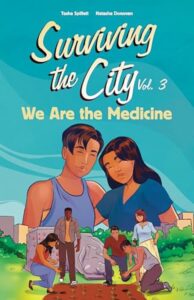Book review: Surviving the City Vol. 3: We Are the Medicine
 Reviewed by Caroline MacKenzie
Reviewed by Caroline MacKenzie
Surviving the City Vol. 3: We Are the Medicine is by Tasha Spillett with art by Natasha Donovan. The colouring and lettering is done by Scott B. Henderson. This is a beautiful and inspiring graphic novel. It is the final instalment for the Surviving the City trilogy about a group of Indigenous youth about to graduate from high school in Winnipeg, Manitoba. In this volume, they learn about the discovery of the remains of 215 unmarked graves on the grounds of a former Indian Residential School in British Columbia. The story follows Dez, who is two-spirit, and their partner Kacey, as well as Miikwan and her boyfriend Riel as they try to find ways to deal with pain and anger this brings up. Ms. Spillett is Afro-Inninew and Ms. Donovan is Métis. The target audience is youth aged 12 to 18 years old.
This story does not minimize what happened at Indian Residential Schools. These events are discussed, as well as the long-term effects they had on students and intergenerational trauma that resulted. We see the effects of this trauma in the behaviour of these young people as they move through certain situations.
The tone of this story is one of anger born from frustration. This anger and frustration come from years of Indigenous people speaking out about abuse at Residential Schools and not being believed, or their experiences being minimized. The tone changes to one of hope, resilience, and strength as these young people try to channel their anger and frustration in positive way and bring people together.
The art is bold and colourful, adding to the tone and beauty of the story. The reader sees the Spirits of those lost to the Indian Residential School System and those recently lost to violence as they appear to be guiding and comforting the main characters as they deal with the news of the discovery of the unmarked graves. This brightness adds to the sense of hope throughout the story.
The characters are relatable, people you could be friends with, keeping the reader engaged. The reader is also introduced to Riel’s cousin, Ginebig who is Afro-Indigenous. This diversity of characters allows the reader to find a character they can relate to, increasing the impact of the story. Furthermore, because the reader has become invested in these characters, they cannot help but be affected by what they are experiencing.
It is through the character of Ginebig, that the story vividly illustrates the blatant racism and police violence Indigenous people are subjected to. The reader sees that this is still happening. This helps the reader to understand why Indigenous people mistrust these institutions as well as the anger and frustration they feel towards them. However, there is a sense of hope as there are also characters who are trying to be Indigenous allies and be a safe space for these young people to talk.
The story line also covers the issue of Missing and Murder Indigenous Women and Girls. Miikwan’s own mother is one of these missing women. This emphasizes to the reader that these women are someone’s mother, daughter, sister, or auntie, reinforcing the belief that these women are important, that their lives have value.
Desspite the target audience age, this book is an amazing resource for those who are looking to gain a better understanding of the experience of Indigenous people and what happened at Residential Schools and how generations have been affected.
Tasha Spillett, Illustrated by Natasha Donovan, Coloured and lettered by Scott B. Henderson, Surviving the City Vol. 3: We Are the Medicine. Winnipeg: HighWater Press, 2024.
ISBN: 978-1774921104


